PUBH6206: Health Promotion Intervention Plan for Childhood Asthma
VerifiedAdded on 2023/06/17
|7
|1509
|239
Report
AI Summary
This report presents a health promotion intervention plan designed to address asthma in children within Australia. It begins with an introduction to asthma, highlighting its impact and prevalence among the pediatric population. The background section delves into the determinants of health related to asthma, such as age, culture, socioeconomic status, and lifestyle, emphasizing the burden of the disease, including hospitalization rates and healthcare costs. The core of the report outlines a health intervention program based on the health belief model, focusing on primary, secondary, and tertiary prevention strategies. The plan includes specific aims and objectives, a detailed timeframe for implementation, and identification of key stakeholders. The report concludes by underscoring the importance of the intervention in changing behavioral and psychosocial approaches to managing asthma, aiming to reduce complications and improve the overall health outcomes for children in Australia. The 'Asthma prevention by health belief model' program spans from community needs assessment to outcome reporting, ensuring a comprehensive approach.

HEALTH
PROMOTION
INTERVENTION
PROMOTION
INTERVENTION
Paraphrase This Document
Need a fresh take? Get an instant paraphrase of this document with our AI Paraphraser
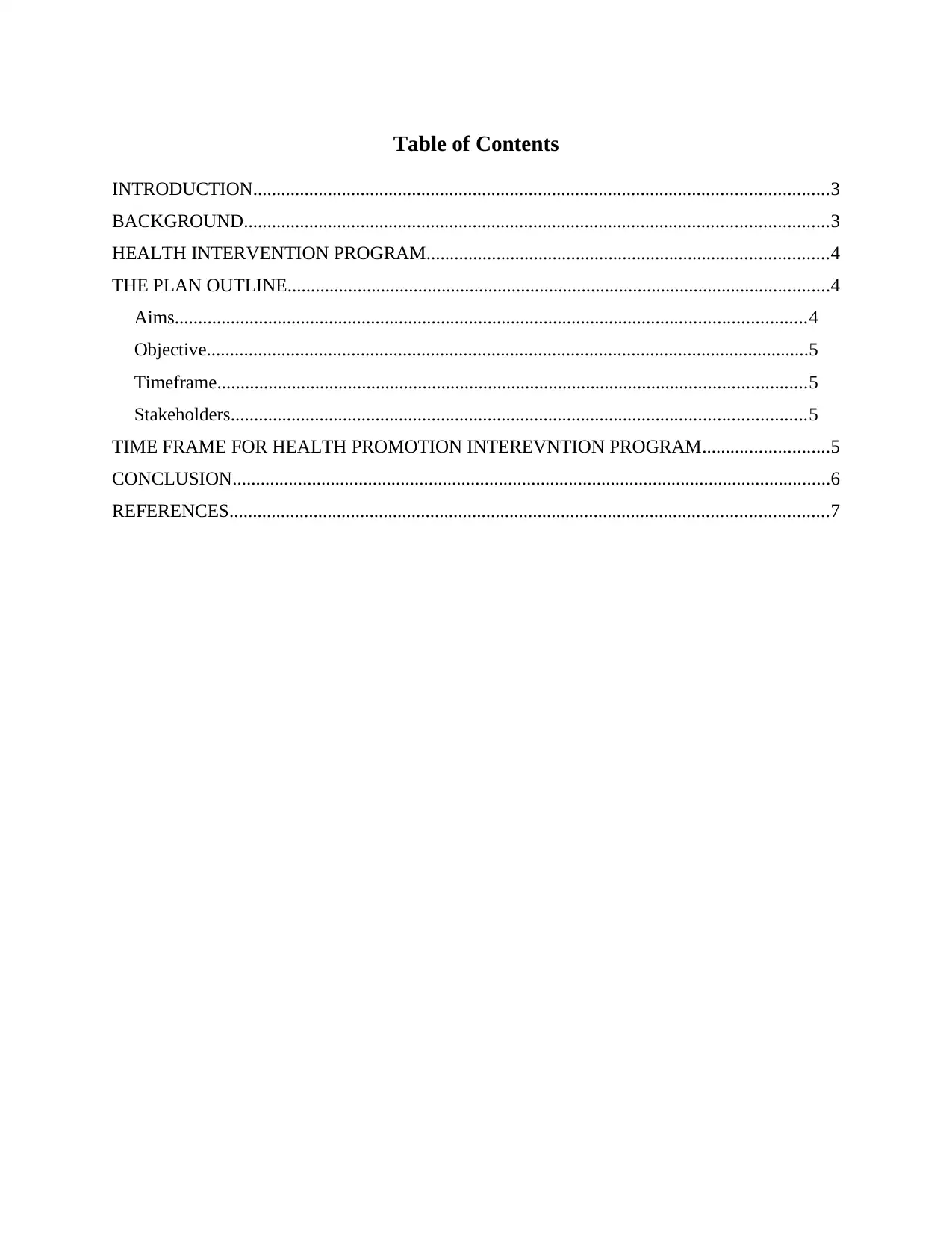
Table of Contents
INTRODUCTION...........................................................................................................................3
BACKGROUND.............................................................................................................................3
HEALTH INTERVENTION PROGRAM......................................................................................4
THE PLAN OUTLINE....................................................................................................................4
Aims.......................................................................................................................................4
Objective.................................................................................................................................5
Timeframe..............................................................................................................................5
Stakeholders...........................................................................................................................5
TIME FRAME FOR HEALTH PROMOTION INTEREVNTION PROGRAM...........................5
CONCLUSION................................................................................................................................6
REFERENCES................................................................................................................................7
INTRODUCTION...........................................................................................................................3
BACKGROUND.............................................................................................................................3
HEALTH INTERVENTION PROGRAM......................................................................................4
THE PLAN OUTLINE....................................................................................................................4
Aims.......................................................................................................................................4
Objective.................................................................................................................................5
Timeframe..............................................................................................................................5
Stakeholders...........................................................................................................................5
TIME FRAME FOR HEALTH PROMOTION INTEREVNTION PROGRAM...........................5
CONCLUSION................................................................................................................................6
REFERENCES................................................................................................................................7
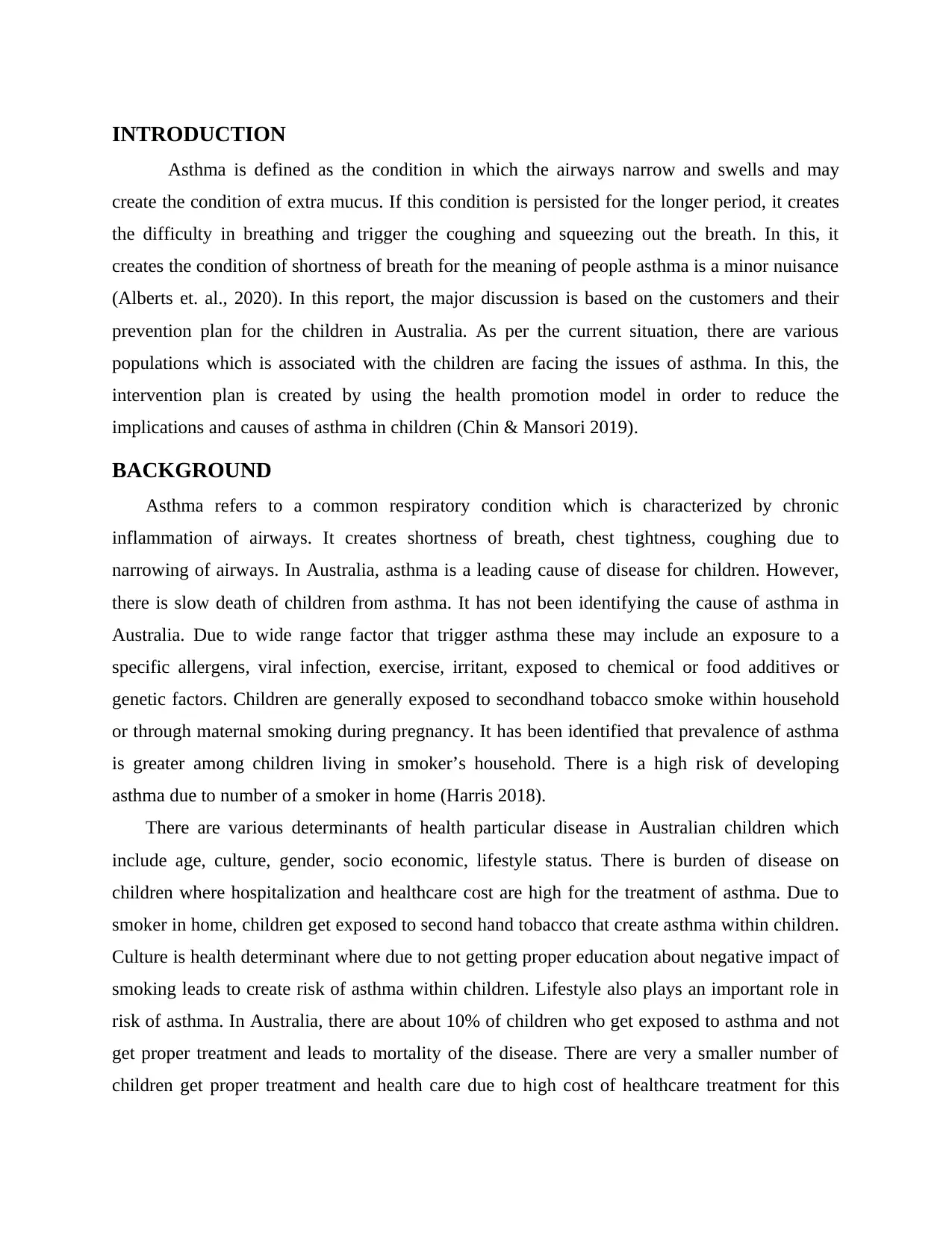
INTRODUCTION
Asthma is defined as the condition in which the airways narrow and swells and may
create the condition of extra mucus. If this condition is persisted for the longer period, it creates
the difficulty in breathing and trigger the coughing and squeezing out the breath. In this, it
creates the condition of shortness of breath for the meaning of people asthma is a minor nuisance
(Alberts et. al., 2020). In this report, the major discussion is based on the customers and their
prevention plan for the children in Australia. As per the current situation, there are various
populations which is associated with the children are facing the issues of asthma. In this, the
intervention plan is created by using the health promotion model in order to reduce the
implications and causes of asthma in children (Chin & Mansori 2019).
BACKGROUND
Asthma refers to a common respiratory condition which is characterized by chronic
inflammation of airways. It creates shortness of breath, chest tightness, coughing due to
narrowing of airways. In Australia, asthma is a leading cause of disease for children. However,
there is slow death of children from asthma. It has not been identifying the cause of asthma in
Australia. Due to wide range factor that trigger asthma these may include an exposure to a
specific allergens, viral infection, exercise, irritant, exposed to chemical or food additives or
genetic factors. Children are generally exposed to secondhand tobacco smoke within household
or through maternal smoking during pregnancy. It has been identified that prevalence of asthma
is greater among children living in smoker’s household. There is a high risk of developing
asthma due to number of a smoker in home (Harris 2018).
There are various determinants of health particular disease in Australian children which
include age, culture, gender, socio economic, lifestyle status. There is burden of disease on
children where hospitalization and healthcare cost are high for the treatment of asthma. Due to
smoker in home, children get exposed to second hand tobacco that create asthma within children.
Culture is health determinant where due to not getting proper education about negative impact of
smoking leads to create risk of asthma within children. Lifestyle also plays an important role in
risk of asthma. In Australia, there are about 10% of children who get exposed to asthma and not
get proper treatment and leads to mortality of the disease. There are very a smaller number of
children get proper treatment and health care due to high cost of healthcare treatment for this
Asthma is defined as the condition in which the airways narrow and swells and may
create the condition of extra mucus. If this condition is persisted for the longer period, it creates
the difficulty in breathing and trigger the coughing and squeezing out the breath. In this, it
creates the condition of shortness of breath for the meaning of people asthma is a minor nuisance
(Alberts et. al., 2020). In this report, the major discussion is based on the customers and their
prevention plan for the children in Australia. As per the current situation, there are various
populations which is associated with the children are facing the issues of asthma. In this, the
intervention plan is created by using the health promotion model in order to reduce the
implications and causes of asthma in children (Chin & Mansori 2019).
BACKGROUND
Asthma refers to a common respiratory condition which is characterized by chronic
inflammation of airways. It creates shortness of breath, chest tightness, coughing due to
narrowing of airways. In Australia, asthma is a leading cause of disease for children. However,
there is slow death of children from asthma. It has not been identifying the cause of asthma in
Australia. Due to wide range factor that trigger asthma these may include an exposure to a
specific allergens, viral infection, exercise, irritant, exposed to chemical or food additives or
genetic factors. Children are generally exposed to secondhand tobacco smoke within household
or through maternal smoking during pregnancy. It has been identified that prevalence of asthma
is greater among children living in smoker’s household. There is a high risk of developing
asthma due to number of a smoker in home (Harris 2018).
There are various determinants of health particular disease in Australian children which
include age, culture, gender, socio economic, lifestyle status. There is burden of disease on
children where hospitalization and healthcare cost are high for the treatment of asthma. Due to
smoker in home, children get exposed to second hand tobacco that create asthma within children.
Culture is health determinant where due to not getting proper education about negative impact of
smoking leads to create risk of asthma within children. Lifestyle also plays an important role in
risk of asthma. In Australia, there are about 10% of children who get exposed to asthma and not
get proper treatment and leads to mortality of the disease. There are very a smaller number of
children get proper treatment and health care due to high cost of healthcare treatment for this
⊘ This is a preview!⊘
Do you want full access?
Subscribe today to unlock all pages.

Trusted by 1+ million students worldwide
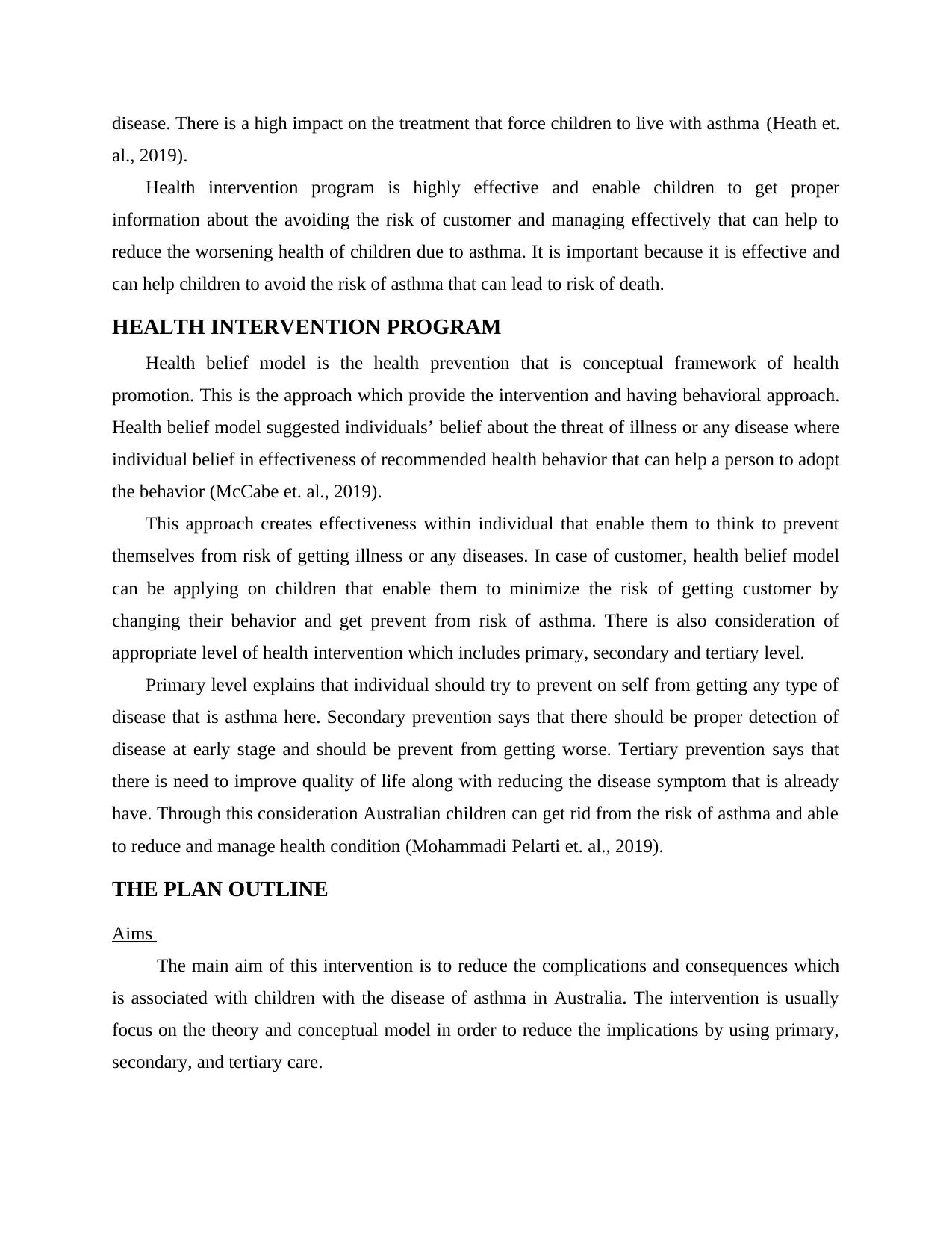
disease. There is a high impact on the treatment that force children to live with asthma (Heath et.
al., 2019).
Health intervention program is highly effective and enable children to get proper
information about the avoiding the risk of customer and managing effectively that can help to
reduce the worsening health of children due to asthma. It is important because it is effective and
can help children to avoid the risk of asthma that can lead to risk of death.
HEALTH INTERVENTION PROGRAM
Health belief model is the health prevention that is conceptual framework of health
promotion. This is the approach which provide the intervention and having behavioral approach.
Health belief model suggested individuals’ belief about the threat of illness or any disease where
individual belief in effectiveness of recommended health behavior that can help a person to adopt
the behavior (McCabe et. al., 2019).
This approach creates effectiveness within individual that enable them to think to prevent
themselves from risk of getting illness or any diseases. In case of customer, health belief model
can be applying on children that enable them to minimize the risk of getting customer by
changing their behavior and get prevent from risk of asthma. There is also consideration of
appropriate level of health intervention which includes primary, secondary and tertiary level.
Primary level explains that individual should try to prevent on self from getting any type of
disease that is asthma here. Secondary prevention says that there should be proper detection of
disease at early stage and should be prevent from getting worse. Tertiary prevention says that
there is need to improve quality of life along with reducing the disease symptom that is already
have. Through this consideration Australian children can get rid from the risk of asthma and able
to reduce and manage health condition (Mohammadi Pelarti et. al., 2019).
THE PLAN OUTLINE
Aims
The main aim of this intervention is to reduce the complications and consequences which
is associated with children with the disease of asthma in Australia. The intervention is usually
focus on the theory and conceptual model in order to reduce the implications by using primary,
secondary, and tertiary care.
al., 2019).
Health intervention program is highly effective and enable children to get proper
information about the avoiding the risk of customer and managing effectively that can help to
reduce the worsening health of children due to asthma. It is important because it is effective and
can help children to avoid the risk of asthma that can lead to risk of death.
HEALTH INTERVENTION PROGRAM
Health belief model is the health prevention that is conceptual framework of health
promotion. This is the approach which provide the intervention and having behavioral approach.
Health belief model suggested individuals’ belief about the threat of illness or any disease where
individual belief in effectiveness of recommended health behavior that can help a person to adopt
the behavior (McCabe et. al., 2019).
This approach creates effectiveness within individual that enable them to think to prevent
themselves from risk of getting illness or any diseases. In case of customer, health belief model
can be applying on children that enable them to minimize the risk of getting customer by
changing their behavior and get prevent from risk of asthma. There is also consideration of
appropriate level of health intervention which includes primary, secondary and tertiary level.
Primary level explains that individual should try to prevent on self from getting any type of
disease that is asthma here. Secondary prevention says that there should be proper detection of
disease at early stage and should be prevent from getting worse. Tertiary prevention says that
there is need to improve quality of life along with reducing the disease symptom that is already
have. Through this consideration Australian children can get rid from the risk of asthma and able
to reduce and manage health condition (Mohammadi Pelarti et. al., 2019).
THE PLAN OUTLINE
Aims
The main aim of this intervention is to reduce the complications and consequences which
is associated with children with the disease of asthma in Australia. The intervention is usually
focus on the theory and conceptual model in order to reduce the implications by using primary,
secondary, and tertiary care.
Paraphrase This Document
Need a fresh take? Get an instant paraphrase of this document with our AI Paraphraser
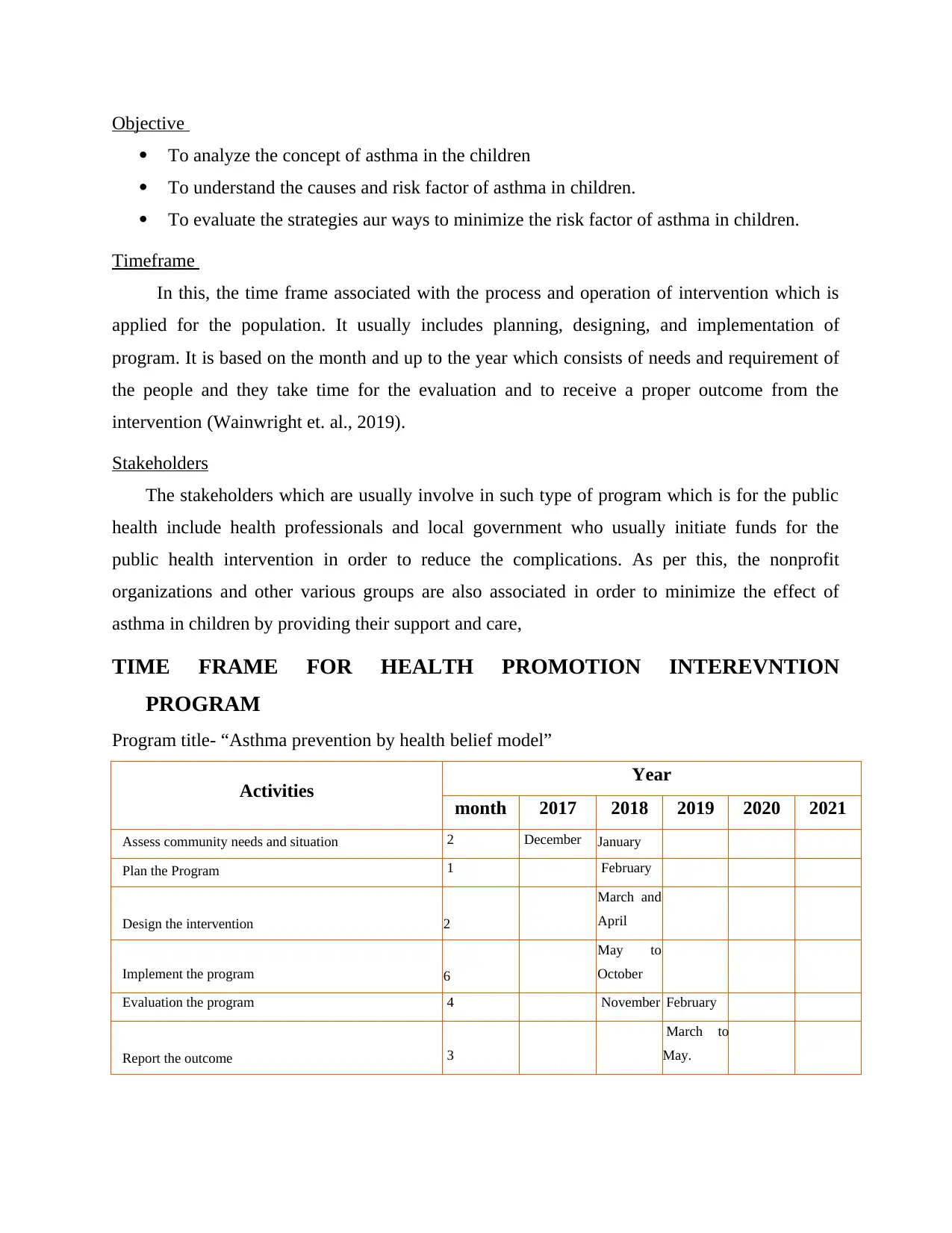
Objective
To analyze the concept of asthma in the children
To understand the causes and risk factor of asthma in children.
To evaluate the strategies aur ways to minimize the risk factor of asthma in children.
Timeframe
In this, the time frame associated with the process and operation of intervention which is
applied for the population. It usually includes planning, designing, and implementation of
program. It is based on the month and up to the year which consists of needs and requirement of
the people and they take time for the evaluation and to receive a proper outcome from the
intervention (Wainwright et. al., 2019).
Stakeholders
The stakeholders which are usually involve in such type of program which is for the public
health include health professionals and local government who usually initiate funds for the
public health intervention in order to reduce the complications. As per this, the nonprofit
organizations and other various groups are also associated in order to minimize the effect of
asthma in children by providing their support and care,
TIME FRAME FOR HEALTH PROMOTION INTEREVNTION
PROGRAM
Program title- “Asthma prevention by health belief model”
Activities Year
month 2017 2018 2019 2020 2021
Assess community needs and situation 2 December January
Plan the Program 1 February
Design the intervention 2
March and
April
Implement the program 6
May to
October
Evaluation the program 4 November February
Report the outcome 3
March to
May.
To analyze the concept of asthma in the children
To understand the causes and risk factor of asthma in children.
To evaluate the strategies aur ways to minimize the risk factor of asthma in children.
Timeframe
In this, the time frame associated with the process and operation of intervention which is
applied for the population. It usually includes planning, designing, and implementation of
program. It is based on the month and up to the year which consists of needs and requirement of
the people and they take time for the evaluation and to receive a proper outcome from the
intervention (Wainwright et. al., 2019).
Stakeholders
The stakeholders which are usually involve in such type of program which is for the public
health include health professionals and local government who usually initiate funds for the
public health intervention in order to reduce the complications. As per this, the nonprofit
organizations and other various groups are also associated in order to minimize the effect of
asthma in children by providing their support and care,
TIME FRAME FOR HEALTH PROMOTION INTEREVNTION
PROGRAM
Program title- “Asthma prevention by health belief model”
Activities Year
month 2017 2018 2019 2020 2021
Assess community needs and situation 2 December January
Plan the Program 1 February
Design the intervention 2
March and
April
Implement the program 6
May to
October
Evaluation the program 4 November February
Report the outcome 3
March to
May.
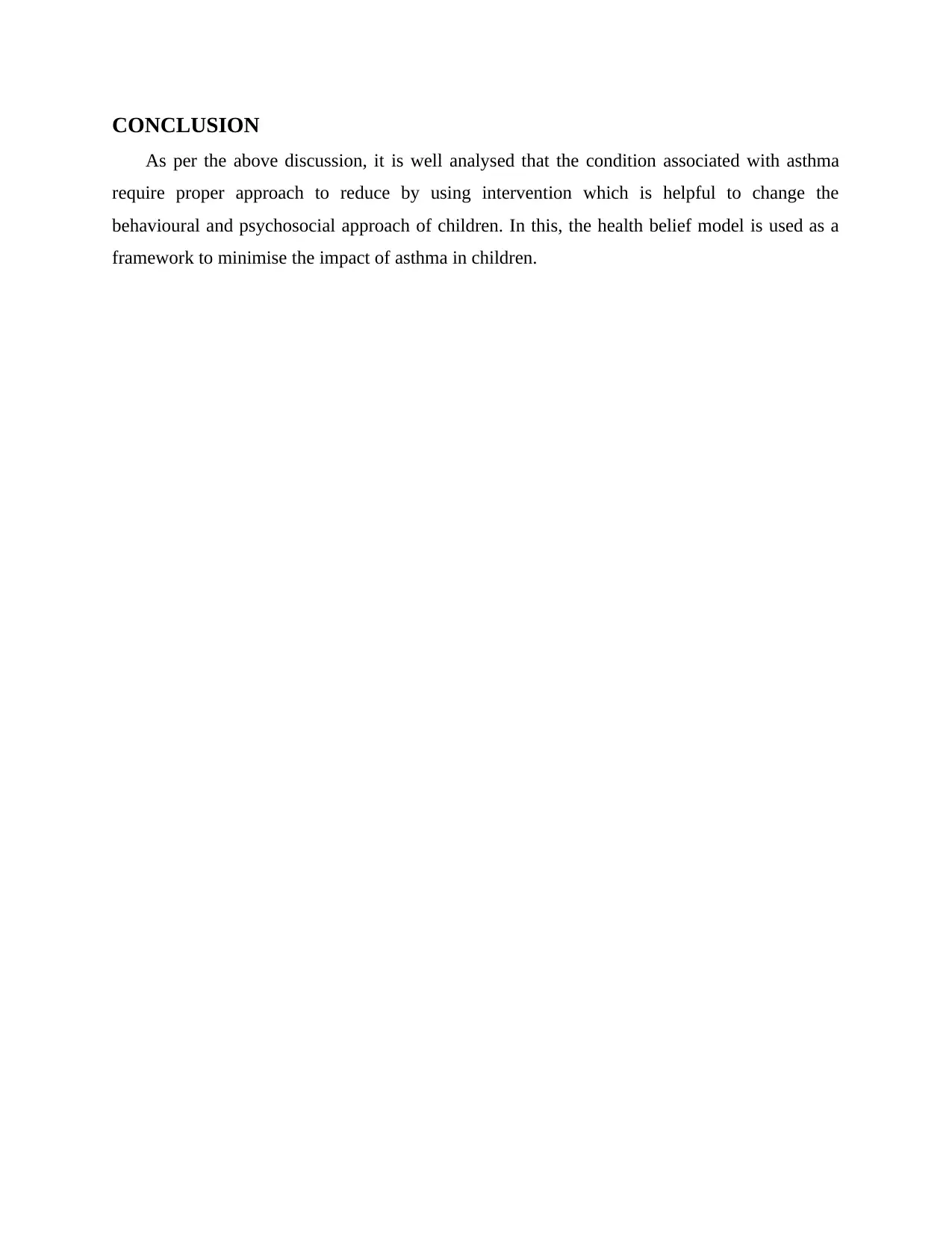
CONCLUSION
As per the above discussion, it is well analysed that the condition associated with asthma
require proper approach to reduce by using intervention which is helpful to change the
behavioural and psychosocial approach of children. In this, the health belief model is used as a
framework to minimise the impact of asthma in children.
As per the above discussion, it is well analysed that the condition associated with asthma
require proper approach to reduce by using intervention which is helpful to change the
behavioural and psychosocial approach of children. In this, the health belief model is used as a
framework to minimise the impact of asthma in children.
⊘ This is a preview!⊘
Do you want full access?
Subscribe today to unlock all pages.

Trusted by 1+ million students worldwide
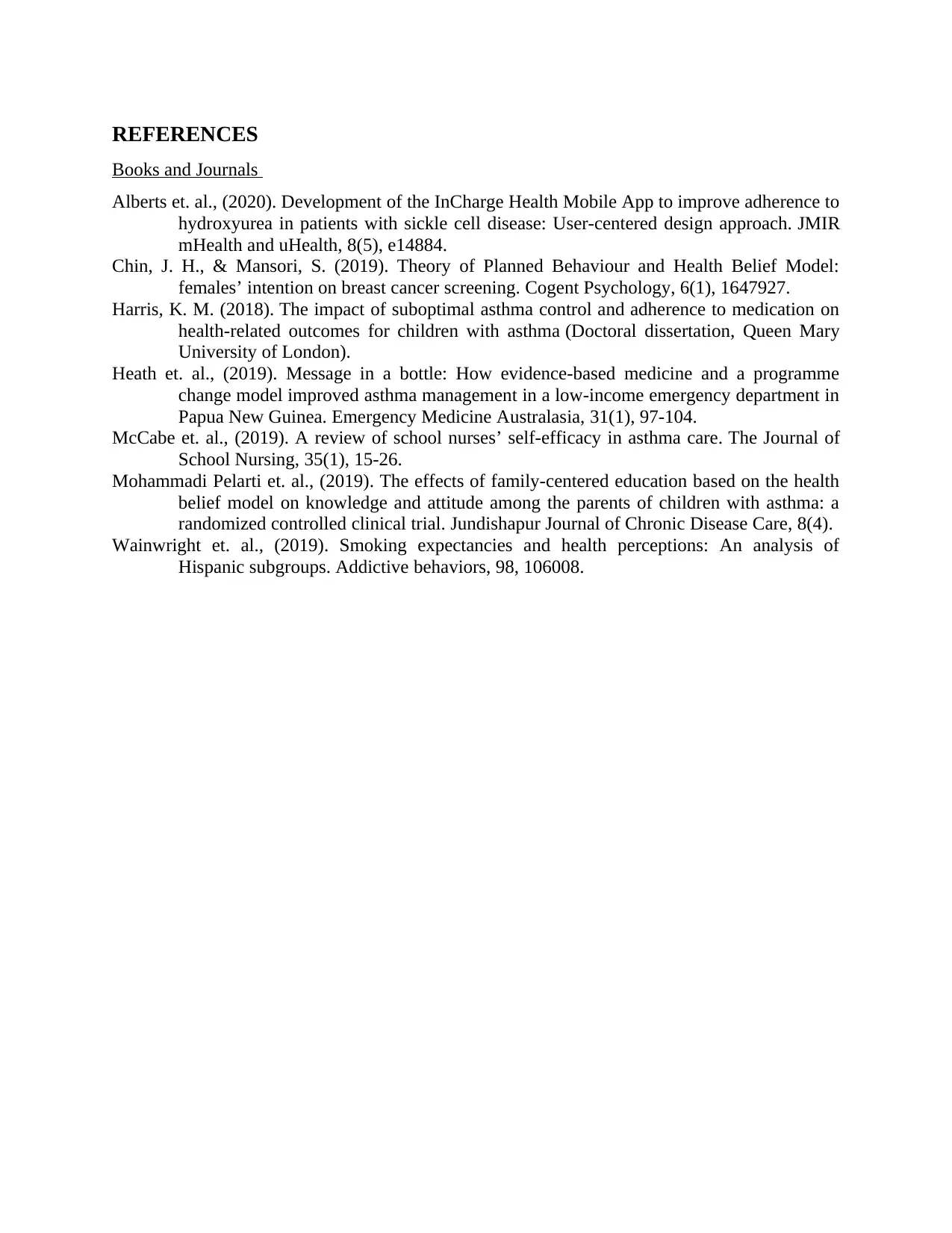
REFERENCES
Books and Journals
Alberts et. al., (2020). Development of the InCharge Health Mobile App to improve adherence to
hydroxyurea in patients with sickle cell disease: User-centered design approach. JMIR
mHealth and uHealth, 8(5), e14884.
Chin, J. H., & Mansori, S. (2019). Theory of Planned Behaviour and Health Belief Model:
females’ intention on breast cancer screening. Cogent Psychology, 6(1), 1647927.
Harris, K. M. (2018). The impact of suboptimal asthma control and adherence to medication on
health-related outcomes for children with asthma (Doctoral dissertation, Queen Mary
University of London).
Heath et. al., (2019). Message in a bottle: How evidence‐based medicine and a programme
change model improved asthma management in a low‐income emergency department in
Papua New Guinea. Emergency Medicine Australasia, 31(1), 97-104.
McCabe et. al., (2019). A review of school nurses’ self-efficacy in asthma care. The Journal of
School Nursing, 35(1), 15-26.
Mohammadi Pelarti et. al., (2019). The effects of family-centered education based on the health
belief model on knowledge and attitude among the parents of children with asthma: a
randomized controlled clinical trial. Jundishapur Journal of Chronic Disease Care, 8(4).
Wainwright et. al., (2019). Smoking expectancies and health perceptions: An analysis of
Hispanic subgroups. Addictive behaviors, 98, 106008.
Books and Journals
Alberts et. al., (2020). Development of the InCharge Health Mobile App to improve adherence to
hydroxyurea in patients with sickle cell disease: User-centered design approach. JMIR
mHealth and uHealth, 8(5), e14884.
Chin, J. H., & Mansori, S. (2019). Theory of Planned Behaviour and Health Belief Model:
females’ intention on breast cancer screening. Cogent Psychology, 6(1), 1647927.
Harris, K. M. (2018). The impact of suboptimal asthma control and adherence to medication on
health-related outcomes for children with asthma (Doctoral dissertation, Queen Mary
University of London).
Heath et. al., (2019). Message in a bottle: How evidence‐based medicine and a programme
change model improved asthma management in a low‐income emergency department in
Papua New Guinea. Emergency Medicine Australasia, 31(1), 97-104.
McCabe et. al., (2019). A review of school nurses’ self-efficacy in asthma care. The Journal of
School Nursing, 35(1), 15-26.
Mohammadi Pelarti et. al., (2019). The effects of family-centered education based on the health
belief model on knowledge and attitude among the parents of children with asthma: a
randomized controlled clinical trial. Jundishapur Journal of Chronic Disease Care, 8(4).
Wainwright et. al., (2019). Smoking expectancies and health perceptions: An analysis of
Hispanic subgroups. Addictive behaviors, 98, 106008.
1 out of 7
Related Documents
Your All-in-One AI-Powered Toolkit for Academic Success.
+13062052269
info@desklib.com
Available 24*7 on WhatsApp / Email
![[object Object]](/_next/static/media/star-bottom.7253800d.svg)
Unlock your academic potential
Copyright © 2020–2025 A2Z Services. All Rights Reserved. Developed and managed by ZUCOL.





